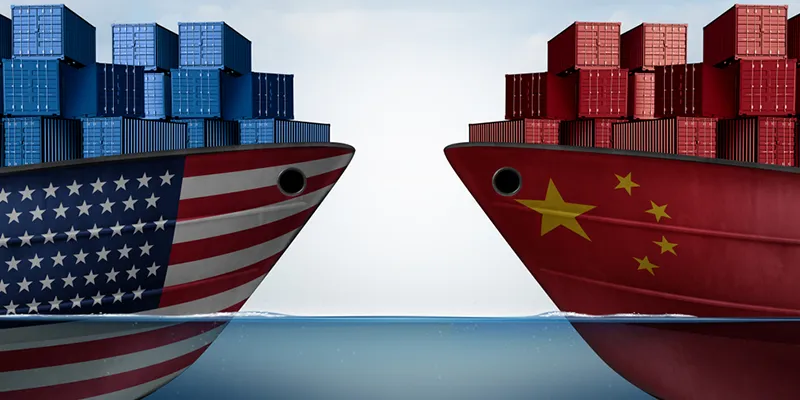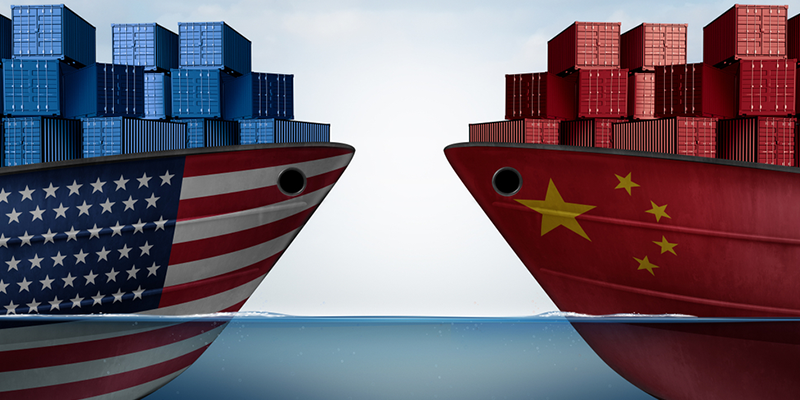China-US Trade War: More of the same; after the temporary truce

Three months ago, while appraising the ongoing China-US trade war, an important assertion that I had made was that the trade conflict was just a partial manifestation of the Greater Institutional Conflict between the two nations, where any cooperation between them is likely to remain conditional, with rivalry remaining the norm.
In that context, where do we stand in the light of the recently concluded trade talks between Chinese Vice Premier Liu He and US Trade Representative Robert Lighthizer and Treasury Secretary Steve Mnuchin, and the one expected to commence again, between the same two interlocutors, next week?
The short conclusion would be that in this round of negotiations perhaps China has given away more than it has received, as its relatively weaker economic position at the start of the talks left it with precious little space to maneuver.
One is inclined to agree with US President Donald Trump of the “tremendous progress” that the US has made in the deal – getting substantial concessions from China, while at the same time making no commitments to ease its impending additional import tariff hike on $ 200 billion worth of Chinese imports (from 10 percent to 25 percent) from March 1. The Chinese have also agreed to buy more from US producers, including soybeans, high-end manufactured and industrial goods, and financial services.
China has likely chosen to bide its time to allow the economy to recover and to let its politicians return home, with some victory
The Chinese government’s agreeability to the US demands in the first round of trade talks, and its somewhat surprising moderation towards the US accusations of technology theft by Chinese firms, seems to have been driven by both circumstantial and strategic reasons.
First, China had little negotiating room to begin with, given that the meeting came on the heels of a 4Q 2018 GDP report that showed the economic growth having slowed down to 6.6 percent y-o-y, the slowest in 28 years. The bite of tariffs and non-tariff barriers for Chinese firms to operate in the US has already exacerbated the pain that the firms had been facing due to a government orchestrated deleveraging since 2017- which has forced unproductive firms to cut debt or close down in order to maintain financial sustainability. Any belligerence could have led to an escalation of trade sanctions by the US, either in terms of tariffs or the scope of industries covered under it. By being somewhat amenable, Chinese negotiators perhaps bought their time to come to the table again later this year, when the domestic economy may look somewhat healthier, not least due to income tax cuts and other consumption subsidies announced by the government at the beginning of this year.
Furthermore, China’s approach to the trade talks has been to preserve a semblance of a dignified truce, and wait for an opportune moment so that the current political establishment can claim some credit before the China’s legislature (National People’s Congress) meets for its annual session in mid-March. In that sense, Chinese political analysts consider the biggest takeaway from the talks to be a commitment from President Trump for a follow-up summit between him and President Xi Jinping. However, as the latest comments from the White House tell us, no talks between the Heads of State are likely to take place before the March 1 deadline for the escalation of tariffs on the US imports of Chinese goods. I believe that the closer the meeting moves to the mid-March legislative session in China, the more intransigent China is likely to be in its demands- as its government officials would prefer to “save some face” before they face the Communist Party rank and file in the People’s Hall. On its part, by appearing to be a reasonable party in the discussions and by acceding to some of US’s demands in the first round of trade talks, China would expect some concessions from US – preferably that they desists from further prosecutions of Chinese national champions like Huawei. Notably, since these talks are likely to be personally led by President Xi, he will have the opportunity to claim any dividends as a personal victory, and therefore burnish his reputation further in the Communist Party.
Finally, even in the latest round of trade talks, China has attached an unsaid conditionality to the access it is allowing to the US firms. For instance, while the Chinese policymakers agreed to buy more of US financial services and high end manufactured and industrial products, there seems to be an ambiguity about dismantling the barriers that have hobbled the international firms from having an equal access to the China’s local market in the first place.
For instance, no measures have yet been taken to address the American grievances on the lax implementation of patents and trademark regime, or what has been termed as a “selective prosecution” of western firms on anti-trust and anti-corruption charges.
Most importantly, the stipulations that require foreign companies to share technology and business practices with local players through a joint venture remain in place; eventually allowing the local firms to emerge as potential rivals to them. Therefore, the fine print could potentially mean that while Chinese authorities will probably allow a discretionary access to US firms for the time-being, the institutional framework regulating the foreign firms’ operation in China will still remain untouchable on the negotiation table, unless US also agrees to make some bold concessions in its demands from China, and/or reins in its attempts to isolate China globally.
The Huawei story is an epitome of the irreconcilable schism between China and the US
So far, it looks as if the negotiations scheduled in the first half of 2019, are structured to allow both the heads of state to go back to their stakeholders with some sort of victories, leaving the broader differences on state involvement in the economy, intellectual property rights and market access – largely unchanged.
That the larger institutional conflict remains alive, despite these soothing assurances from the political leaders of both countries, was highlighted in the comments on February 1 by the US Ambassador to the European Union, Gordon Sondland.
Speaking at a telecom conference in Brussels, Sondland urged European firms and policymakers to “not let China control your networks”, and to specifically shun firms such as Huawei, which it believes are “subject to foreign government control”.
It is to be noted that Huawei is involved in or is expected to bid for installation and management projects for 5G Infrastructure in a number of European countries, including Poland, France and Germany. Australia and New Zealand have already heeded US’ concerns, banning Huawei equipment in 5G carriers; this has created an impression, at least in the eyes of the Chinese government that trade tariffs and the case against Chinese global technology players are two prongs of the same battle strategy- to block its rise as a technological and global power. These comments come not long after US government prosecutors filed charges against Huawei on January 28, alleging theft of trade secrets and bank fraud by committing a violation of US sanctions against doing business with Iran. It is to be noted that the current CFO of Huawei, Meng Wanzhou, who also happens to be the daughter of the company’s founder Ren Zhengfei, is also indicted as guilty in the lawsuit against Huawei.
As with the dispute over China’s trade surplus, which eventually led to the trade war that riled the international financial markets last year, is there a way to amicably resolve the US misgivings about the Chinese firms? I believe that rapprochement is likely to be more difficult than a resolution to the trade war. The reasons behind it lie in the differing view that Chinese and US governments have about the reach of the government, independence of institutions and of each other’s ulterior motives.
While US actions against Huawei may not be politically motivated, China finds it difficult to believe they are not
First, there is a marked difference in which the arrest of Huawei CFO on violation of Iran sanctions was covered by the Chinese media. The papers unequivocally termed the arrest and the lawsuit as “politically motivated”, caring little about confirming or denying the veracity of the charges themselves. This perspective is rooted in China’s own view of its law enforcement institutions, which are naturally assumed to be another division of the Party-controlled government, and do not have as watertight separation in powers as is the case with judiciary, prosecution and the government in the United States. Domestic lawsuits against powerful politicians, civil servants or businessmen in China are initiated by the public prosecutors on the directions or with the permission of the executive branch of the government, and domestic courts actively fast-track such cases. Rarely if ever, has a verdict been given by the courts in China, which contradicts the government’s stance in a public litigation. Given this paradigm, it is difficult for the local authorities in Beijing to believe that the US government hasn’t pushed its own law enforcement institutions to use the arrest of the Huawei CFO as a bargaining chip in the trade discussions.
Indeed, the off-hand remark by President Trump, in the weeks leading up to the summit, where he suggested that the charges against Meng may be reviewed, gives further credence to the Chinese suspicions about a “political targeting” of successful Chinese nationals, much as it undermines the reputation of US institutions.
Therefore, any subsequent clarifications from the US authorities, that the prosecution of Huawei on intellectual theft and sanction violation charges are separate from the issue of trade dispute, is unlikely to be accepted by the Chinese authorities.

China accuses US of double standards on technology theft; also, the definitions of what constitutes such a crime vary between the two countries.
Second, the actions taken by the US have failed to address China’s concerns that US is using “intellectual property rights” as an excuse to block China’s rise. First, as several Chinese commentators have recently begun to point out, US has no right to lecture China on intellectual theft, when its own industrial revolution was founded on outright industrial espionage. These claims are true – as economic historian Doron Ben Atar points out in his book Trade Secrets. In the 1780s-90s, American inventors were easily getting patents for technology pirated from abroad. Samuel Slater, the father of US industrial revolution, had a very different reputation across the Atlantic. He was called “Slater the Traitor” in Britain, for having memorized and passed on the design of Arkwright spinning mills to American businessmen in Rhode Island, helping establish the first textile mill in the United States. Furthermore, this piracy was not being carried out in the absence of any law to regulate it. Britain already had, in the late 18th century, laws in place to limit the export of critical technology and skilled workers.
Therefore, such an illicit transfer of technology was being carried out in violation of the existing laws in Britain. Moreover, British themselves were guilty of stealing silk weaving technology from the Italians in the 18th century, when a British textile worker John Lombe sketched copies of machines in silk spinning establishments of Italy, which was forbidden by law at the time. As per this argument, every emerging power has either tried to circumvent the existing intellectual property laws or has tried to clandestinely overlook technology theft from abroad by its businesses.
Furthermore, a divergent view on what constitutes a technology theft once again raises a roadblock for a successful resolution of trade conflict. In particular, Chinese patent laws, even for domestic firms, tend to have a more lenient view towards the degree of protection afforded to innovation. Indeed, as I pointed out in my previous article on Innovation in China, the threat of copying itself had a big role to play in spurring the pace of technological acceleration. The absence of strict non-compete clauses in most Chinese technology giants, allows bright people to move from one tech firm to another (as they do in the Silicon Valley), carrying with them ideas from the old firms, over which they improvise in a new place.
China denies using its tech companies for espionage; Western countries are not convinced
Third, the recent round of trade talks is unlikely to have assuaged the anxieties of US and its allies around the suspicions of espionage by Chinese technology firms. While there have been no proven cases of Chinese intelligence services using technology firms operating in foreign countries to collect sensitive information about their citizens and governments, the culpability of such an act is hard to deny. As I have noted earlier, the close ties of Chinese firms, even the private ones, to the Communist Party, and the requirement to keep an active division of the Party operating within the firm to align the incentives of the firm and state, remains at the center of this suspicion. Therefore, even though the Chinese government may not be using its technology firms to gather intelligence on other countries, that it can accomplish it very easily should it desire to, continues to remain a problem towards any normalization of ties between US and China. The National Intelligence Law of the People’s Republic of China (2018 Amendment) sits at the center of this objection. In particular focus is the Article 7 of this law, which states that:
An organization or citizen shall support, assist in and cooperate in national intelligence work in accordance with the law and keep confidential the national intelligence work that it or he knows.
On the face of it, a stipulation for organizations (firms) to cooperate with intelligence agencies in gathering intelligence is not unique to China. In fact, most other nations in the world, including the US, have similar laws which require firms to cooperate with the intelligence agencies to gather information that could be sensitive to national interest. However, in China’s case, there are two open areas in the legal language, which could allow the state, in theory, to use Chinese technology firms to conduct active espionage. First, there is no clarity around the conditions under which the intelligence agencies could make a request to Chinese firms to cooperate with intelligence gathering. Ergo, it is not clear whether this intelligence gathering likely to be investigative, in order to defend the country, or something similar to a persistent surveillance without a warrant? Secondly, unlike US, the firms in China do not have enough safeguards to deny intelligence gathering requests which they could deem excessive. For even though they could in theory file complaints protesting against intelligence gathering requests if they feel them to be unnecessary or risky to their corporate reputation abroad, they would be limited in the legal assistance provided to them. The 2016 law on regulations of law firms, strictly constrains law firms from undertaking cases involving national security.
China’s technological revolution is maturing; it isn’t just innovating faster than before; it is also writing the rules on how such innovations will interact with our world.
Finally, another aspect that could prevent any reconciliation between US and China in the longer-term is the extraordinary rise in China’s leadership in institutions governing the regulation of new technology. To understand why that is important, we must consider the concept of hegemony, where the most powerful nation of the day does not just exert its influence through military and economic clout, but also by shaping international multilateral institutions in ways that serve or promote its own interests. In particular, this strategy manifests itself through the hegemon taking the final call in setting the standards for multilateral organizations that would define the protocols through which countries interact with each other. This is indeed what US did in 1944 when it took over from the UK as the global hegemon, establishing the IMF and the Bretton Woods system which puts the US Dollar at the center of the world’s financial system. Earlier, the British had done something similar when international maritime trade was emerging as a key channel for accumulating power and influence in the world- international sea laws today derive their origins from the British maritime laws of the 18th and 19th centuries.
China’s growing clout in the standard setting bodies for international telecommunication can be seen as a part of that same trend. Currently, Chinese firms and government research institutes hold the largest number of seats in International Telecommunication Union’s (ITU) 5G-Standard setting bodies. Furthermore, Houlin Zhao from China, is the first from his country to become the Secretary General of ITU; he was unanimously elected to this position in 2014. As a specialized agency of the United Nations, a key role that ITU plays is in coordination and development of worldwide technical standards. In this capacity, it has a vital part in defining the standard procedures, guides, testing methods and specification for telecommunication technologies, and thus has an important say in determining the validity of patents.
In the context of 5G, the dominance of China in international standard setting bodies becomes even more alarming to the US, since standards guided by Chinese policymakers on ITU will likely determine how millions of connected devices communicate with each other and how data access and privacy laws in a 5G- world are written.
Furthermore, Chinese firms already hold 10 percent of the patents for technologies and equipment essential for operating 5G network, a share that is likely to rise as Chinese members of the ITU decide what constitutes a valid patent. This means that sanctions on Huawei and other Chinese telecom giants notwithstanding, their control of the regulatory bodies on telecommunication is likely to keep them profitable, as the users of such patents are likely to continue paying them royalties.
It is not very tough to understand why China’s pre-eminence in setting the standards for 5G technology should be a sticking point for the US-China institutional conflict. By 2020, as per the Bank of America, there will be 30-40 billion connected devices operating on 5G networks and over 200 billion sensors capturing data about people, which could possibly be stored and disseminated as per the protocols agreed upon by the ITU today. Furthermore, over 50 percent of US homes are likely to have at least one smart home device operating on 5G, by the middle of the next decade- a level of control that closely resembles how internet, maintained and coordinated by US-based ICANN, emerged as a ubiquitous presence in our lives a generation ago.
To conclude, President Trump’s current claim that “tremendous progress” has been made in the trade talks is likely to end up being a temporary truce in the protracted institutional struggle between China and the US, for four reasons. First, China remains suspicious that the US is trying to block its rise through politically motivated charges against its industry titans. Second, there is a stark difference in perspective that the US and China have towards intellectual property and the separation of powers in the government. Third, there are somewhat justified misgivings that the rest of the world has about China’s capability to use its technological infrastructure for espionage. Fourth and finally, the gradually rising control of China over multilateral bodies that will set the standards for emerging technology mean that the economic and business landscape the next generation lives in, will be shaped by a Chinese perspective on institutions, businesses, markets and technology.
Given that such a power struggle now looks inevitable, the question before other countries then is, if we seem to be hurtling towards another Cold War, how should we position ourselves?
(Disclaimer: The views and opinions expressed in this article are those of the author and do not necessarily reflect the views of YourStory. The author was named YourStory's Top Emerging Voice on Asian Macro and Markets-2018.)











